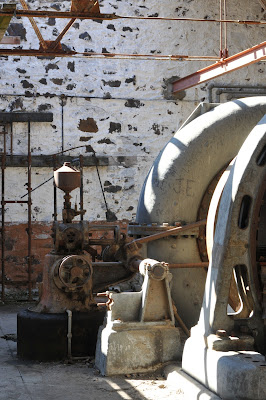I have an affinity for old, abandoned buildings. I always have, even as a child I remember an old house near where I lived in North Vancouver, British Columbia. It was derelict, with the windows broken and walls kicked in by so many youngsters (and perhaps older kids) before me. I couldn't bring myself to do more damage, but the result of the vandalism of others allowed me a glimpse of something new. I think part of the fascination was seeing the guts of a building...the skeleton of the structure and the nervous system of the wires all played into the anatomical analogy.
So one can imagine my delight upon finding this abandoned powerhouse in Central Oregon. Originally built in 1910, this hydroelectric plant took water diverted from the White River (at the White River Falls), before meeting the Deschutes River a few miles downstream. It ceased operations in 1960 and fell into disrepair since. Like the old house of my childhood, one can imagine all sorts of people coming in and perhaps kicking in the walls and stripping the old turbines and generators of their guts. Personally, I tend to walk in somewhat reverentially...or perhaps cautiously so as to not fall through a hole.
This is what one sees from the viewpoint near the highway, as the White River threads its way through the canyon.
Built of stone most likely obtained nearby, the building blends in with the bluffs in the background. What I find particularly compelling is the process of decay, and how the structure continues to break down while the surrounding plants slowly encroach and take over.
Inside are the remains of the old Pelton water wheel turbines, the speed governors (just to the left of the turbine housing), and the generator. Almost all of the equipment has been eviscerated of their innards, like the copper windings that lined the stators and rotors of the generator (seen below).
I tend to view something like this rather poetically, and as a glimpse into the past. Of course the technology is primitive by today's standards, but one can certainly appreciate the ingeniuty of those who built such pioneering structures, that perhaps lit the first lightbulbs of the pioneer homes originally illuminated by candles and kerosene.
Close-up of the speed governor
Of course, General Electric supplied the equipment for many of the hydro plants built during this era.
Another view of the rusting hulks of the turbine housings
This is a view through one of several wall penetrations, looking up to the viewpoint from which the first image was taken, showing the canyon and the powerhouse along the river (at the top of this post). I don't know if this was a window or where a pipe used to come through the wall.
Nature will eventually take over and the building will vanish, allowing the wildlife to return.
White River Falls is a spectacular and beautiful sight, seen here from the powerhouse.
As for the something new, Henry Shukman writes in his article "After the Apocalypse", about the environment around the Chernoble Nuclear Plant after it's meltdown 25 years ago in 1986 and how nature is reclaiming the land around the plant, not unlike the White River plant...save for a very profound difference in how the radiation has affected Chernobyl's surrounding flora and fauna. To read more, see the link below:
For more information on the White River Falls site, click here: http://www.oregonstateparks.org/park_36.php










1 comment:
Neat pictures Paul! Though the stone walls of the plant will be standing for hundreds of years after the rest is lost to nature.
An interesting book I'd recommend is "The World Without Us" by Alan Weisman. In it, he devotes a chapter to nature's reclamation of the Chernobyl evacuation zone. A captivating read!
Post a Comment